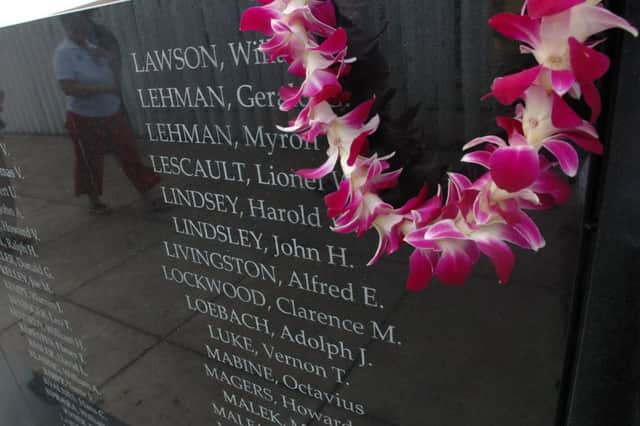Pearl Harbor dead to be exhumed


This week that day moved a step closer when the US military announced it would exhume and attempt to identify the remains of almost 400 sailors and Marines from the USS Oklahoma who were buried as unknowns after the war near the Hawaiian base.
Mr Gray’s cousin, Edwin Hopkins, of Swanzey, New Hampshire, was a 19-year-old fireman third class on board the USS Oklahoma when the battleship was hit by nine torpedoes and capsized on 7 December, 1941. His remains weren’t identified and his family was told he was missing.
Advertisement
Hide AdAdvertisement
Hide AdMr Gray said Hopkins’ mother never accepted that. She believed he had amnesia and he would show up one day, he added.
Hopkins’ parents, Frank and Alice Hopkins, put his name on their headstone in Keene, New Hampshire, thinking he would join them one day, Mr Gray said, adding they did so, “just waiting for him to come home.”
A total of 429 sailors and Marines on board the Oklahoma were killed. Only 35 were identified in the years immediately afterwards. Hundreds were buried as unknowns at cemeteries in Hawaii. In 1950, they were reburied as unknowns at the National Memorial Cemetery of the Pacific inside a volcanic crater in the capital Honolulu.
The military is acting now because advances in forensic science and technology have made it possible to identify more remains, according to a defence spokeswoman.
She said officials plan to begin the work in three to six weeks. They aim to identify the remains of up to 388 servicemen within five years.
US department of defence officials confirmed that the identification effort would be helped by forensics, but also genealogical help from family members.
Deputy secretary of defence Robert Work said: “While not all families will receive an individual identification, we will strive to provide resolution to as many families as possible.”
In 2003, the military disinterred one casket from the Honolulu cemetery, commonly called Punchbowl, based on information provided by Ray Emory, a Pearl Harbor survivor who has spent years doggedly scouring documents.
Advertisement
Hide AdAdvertisement
Hide AdMany remains were co-mingled when buried, and the military was able to identify five servicemen from that casket. But the coffin also contained the remains of up to 100 others who have not been identified.
Mr Gray said his family in 2008 learned from a group of USS Oklahoma survivors that Mr Emory had identified discrepancies in the records of the 22 buried as unknowns, including his cousin.
The 22 are buried in about five graves at Punchbowl, added Mr Gray, who lives in Guilford, Connecticut.
He said: “Since then, the families have been fighting to have these sailors disinterred and brought home.”